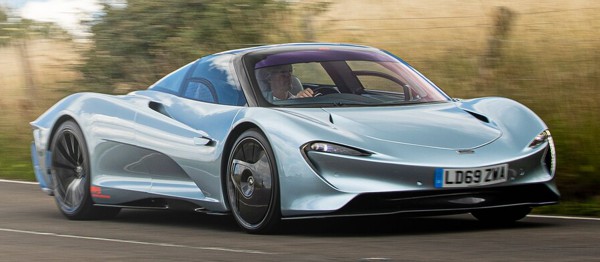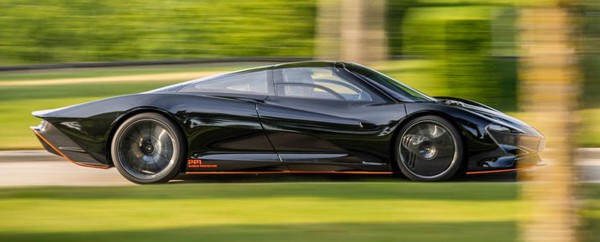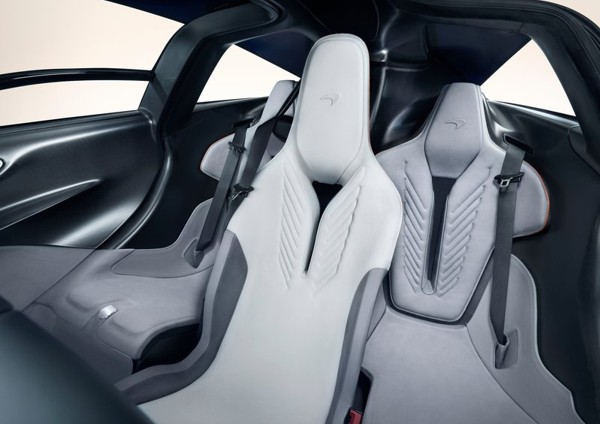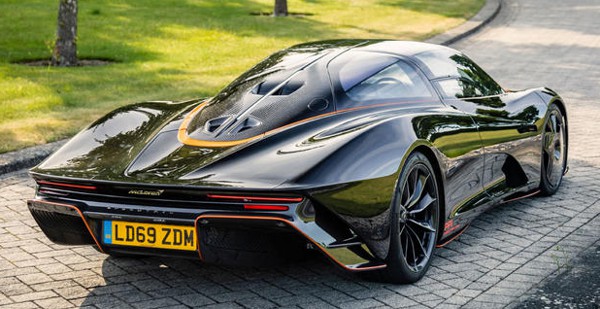| Published
on 31
Mar 2021 |
All rights reserved.
|
|
|

|
|
McLaren
calls it a "Hyper-GT" rather than a super sports car, but its true
identity is not as clear...
|
|
What is Speedtail? It is
the 3rd Ultimate series car introduced by the reborn McLaren. What does
it want to achieve? This question is more difficult to answer. Although
the Speedtail is both pricier and rarer than the P1 and Senna, it is
neither the successor of them nor a superior one. Think about this: the
P1 occupies the middle of the road in the hypercar spectrum. It is
extremely fast yet usable on both road and track. You can drive it to
pubs one evening and fly it lap after lap on a track the next morning.
In contrast, Senna is purely focused on track performance. Its
downforce-optimizing aero and hardcore suspension setting are more
suitable to tracks than roads. At the opposite end of the spectrum is
Speedtail. McLaren calls it a "Hyper-GT" rather than a super sports
car. This means it is designed purely for road use, especially wide
open roads and long straights traditionally dominated by the
front-engined GTs from Ferrari and Aston. Should you drive it to Alps
and attack the twisty mountain passes, you are very likely to have its
very long tail scratched and damaged. This car is incredibly long at
5137mm, a massive 550mm longer than the P1 !
Undoubtedly, the Speedtail is shaped by aerodynamics. Whereas P1 and
Senna are optimized for downforce, it focuses on low drag. Although the
press release of McLaren offers no aerodynamics figures at all, it
mentions "drag" as many as 19 times, while "downforce" occurs just
once. This is evident from its teardrop shape. To reduce frontal area,
it is made narrower than the P1, and its hydraulic suspension can lower
the car at speed by 35mm, reducing the overall height to merely 1120mm,
which beats even Lamborghini Aventador (1136mm). To reduce drag
further, its full carbon-fiber body shell uses as few panels as
possible, so to reduce assembly gaps. These include the 2 active rear
spoilers, which are extensions of the flexible carbon-fiber rear
bodywork thus have no gaps at the hinges. Besides, the car adopts also
retractable rearview cameras instead of door mirrors to cut drag. Oh
yes, the front wheels are covered to smooth air flow, too.

|
|
There
is nothing innovative in the Speedtail, as the P1 already provides the
technical basis, whereas the old F1 provides the inspiration.
|
|
Why does it emphasize so much on low drag? Because the car needs a
250mph top speed to better the legendary McLaren F1, which set a 2-way
average world speed record of 240.1mph more than 20 years ago. Well, I
agree this is pointless, because it fails to match even an old Bugatti
Veyron SS (268mph), let alone the latest Chiron and the current world
record holder Koenigsegg Agera RS (277.9mph). Is it wise to talk so
much about low drag and eventually say "we are not interested to
challenge world speed record?" If not, what's the point to achieve the
lowest drag? To beat Rolls-Royce in the contest of "the quietest
cruiser"?
I hope that is not the case. Throughout the press release, McLaren
mentions the word "luxury" 6 times. OMG, a luxury McLaren! If luxury
could be measured by seat count, it might be, because the Speedtail has
3. The driver sits centrally and sandwiched by 2 passengers, yes, just
in the same layout of McLaren F1. This is why the Speedtail is
described by some as "the new F1". Luxury might be measured by the
number of LCD screens as well, as this car has 5, including 2 for
displaying the images from rearview cameras. Besides, it has 2 luggage
compartments, one at each end of the car. If all these are the signs of
luxury, let it be.

|
|
Is
it wise to talk so much about low drag and eventually say "we are not
interested to challenge world speed record?"
|
|
Well, I am more interested in the mechanical specifications instead.
Unfortunately, McLaren offers little, and some contradict to each
other. For sure the Speedtail is powered by just another version of the
flat-crank, 4.0-liter twin-turbo V8 that serves all of its cars (well,
some in 3.8-liter form). It produces 746 horsepower and 590 lbft of
torque, a little down on Senna, but supplemented with a quite powerful
electric motor mounted between the engine and gearbox. Combined output
must be either 1036, 1050, 1055 or 1070hp, depending on where you read
it, but listing 1036 bhp and 1070 ps simultaneously as on McLaren’s
official website must be wrong, as 1036 bhp translates to 1050 hp while
1070 ps is equivalent to 1055 bhp. Anyway, it is at least 120
horsepower more than P1, and its 848 lbft of peak torque beats that
car’s 664 lbft easily.
There is nothing innovative in the Speedtail, as the P1 already
provides the technical basis, whereas the old F1, especially its
longtail GT version, provides the inspiration. The rest of the
mechanicals, like hydraulically interconnected suspensions, twin-clutch
gearbox, Brembo CCM-R brakes and old-school electrohydraulic steering,
are sourced from the existing parts bin. McLaren should have used it as
the test bed for its second generation hybrid system, but sorry, that
task is left to the Artura. The Speedtail’s electrical system is no
more advanced than that of the P1. Obviously, its battery is small, so
it offers no zero-emission driving mode. It is not plug-in either,
although it supports induction charging – again implying a small
battery. How small? McLaren would not tell us. Unlike Porsche 918
Spyder, Honda NSX or Ferrari SF90, its hybrid system does not have any
front motors, so it sacrifices an opportunity to improve traction and
cornering agility for less weight and complexity.
The carbon-fiber monocoque is taken from other McLarens, although it is
modified at both ends to accommodate the central driving position and
provide more space for battery. Being an Ultimate series model, full
carbon-fiber body panels are employed, of course. For sure, the
Speedtail is much lighter than Bugatti, but not quite as light as the
P1 or Senna. How much does the whole car weigh? Hard to tell. Sometimes
it is quoted 1430kg in dry, sometimes 1499kg kerb weight but also
1597kg, figures that don’t add up.

|
|
If
luxury could be measured by seat count, it might be, because the
Speedtail has 3.
|
|
And then you might concern the use of relatively narrow tires – Pirelli
P Zeros measuring 235/35ZR20 up front and 315/30ZR21 at the rear.
Aren’t they too modest for a 250mph hypercar? Consequently, the
Speedtail struggles for traction in standing start acceleration. It
will spin its rear wheels in the first 3 gears, needing the traction
control to work overtime to tame wheel spin. As a result, it doesn’t
feel as quick as it should be. 0-60 and 100 mph take 2.9 and 5.1
seconds, respectively, slower than the P1 and most of its latest
rivals. However, once its wheels gather speed, the sleek body slips
through the air more easily than others, and the car becomes quicker
and quicker. By 200km/h (124mph), it overtakes the P1 (6.6 vs 6.8 sec).
By 300km/h (186mph), it knocks out Bugatti Chiron (13.0 vs 13.6 sec).
The slippery body makes its 1036 / 1050 / 1055 / 1070 horsepower far
more useful than the Bugatti’s 1500 horsepower, and the car’s 500 kg
lighter weight helps as well.
Nevertheless, the McLaren still trails a number of Koenigseggs, such as
One:1 and Regera, in the chase for 0-300 km/h. The Koenigseggs are
lighter and similarly slippery, and almost certain to run higher top
speeds with their more powerful engines. No wonder McLaren decided to
set its speed limiter to 250 mph.
Lacking originality and innovations, its high price, £1.75
million before taxes, is probably not worthwhile. The only excuse is
rarity, as its production is limited to 106 cars to match the old F1.
Then again, McLaren is easy to create another special edition like this
every year. Billionaires, it is time to wake up. Not every expensive
supercar can repeat the legend of F1.

|
|
Unfortunately,
having adjusted your seat to feel comfortable, you will find the 2
passengers complaining for lack of shoulder room.
|
|
On the Road
It must be said that the opportunities McLaren offered journalists to
test drive the Speedtail have been limited, either on an airfield or
limited mileage on roads. No proper test track, no challenging mountain
roads either, understandably. And the car was a prototype rather than
the final product. More than 2 years have gone since the car’s
introduction, but still neither production cars nor full specifications
are available.
The long tail certainly looks spectacular from the rear. Its teardrop
body is also easy to eyes, but somehow the Speedtail lacks a bit of
sense of occasion, unlike a Lamborghini Miura or Ferrari Daytona gave
you in their time. Why? Perhaps we have got tired of the trademark
McLaren design – that same windscreen, that front end shape and
headlights. Even that glasshouse and cut-size winding windows seem not
that special after the taste of Senna. McLaren needs to think harder
how to breath new inspiration into its hypercar design, not just give
us another derivative of its existing styling.
Inside, there are pros and cons. On the plus side, the central driving
position is fabulous for visibility and driver judgment, so good that
you won’t want to go back to conventional cars. The 3 screens
surrounding you – for displaying instrument, sat-nav/air-con and
phone/audio, respectively – are intuitive. Less so for other buttons,
which are hidden under eye level or at the roof liner. Is it
comfortable and convenient enough to use as a “hyper GT”? Not quite.
Despite the butterfly doors opening part of the roof, you still need to
learn gymnastic to climb onto the center seat, threading both legs into
the narrow and deep foot well. Having adjusted your seat to feel
comfortable, you will find the 2 passengers complaining for lack of
shoulder room. Yes, the claim for 3-seater might sound fancy, in
reality this cockpit is not wide enough for the task. I wonder why the
old F1 had not been reported for such a problem. Perhaps its dedicated
monocoque placed the driver closer to the front, freeing more room to
the passengers. As it is, the passenger seats of Speedtail is virtually
unusable for any normal size adults. How lonely!

|
|
It
rides unreasonably good for a fast car, but what the car does best is
still the sports car thing.
|
|
That GT claim might be supported by the generous luggage space provided
up front and behind the engine compartment, by the leather trimmed
cabin or the Bowers & Wilkins sound system, but on the roll, the
McLaren is still a McLaren. It might be quieter than a 720S or the
McLaren calling itself “GT” (which is not), but the gruffy soundtrack
of its flat-plane V8 is far from melodic, and it still doesn’t suppress
road noise as good as a GT should.
The Speedtail rides unreasonably good for a fast car though, not just
on wide open roads but also the worst stuff. That is always the case
for the 720S or the preceding 12C, which lend it their sophisticated
hydraulic suspension system. The 58mm longer wheelbase and a slightly
softer suspension setup just makes this case even smoother. If McLaren
decided to go beyond 250mph, it might need to employ stiffer springs
and ruin the ride quality.
However, what the car does best is still the sports car thing. Despite
its added length, it is still a relatively lightweight. It steers, it
controls its body movement and it brakes just as good as a 720S, with
just a little bit poise and agility traded for extra directional
stability. It is also engaging, through the steering and rapid change
of direction. Power slide? Assuming you find a wide open bend and don’t
mind risk scratching the tail, it is possible, although not something
it is designed for.
Then you might ask: why don’t buy a 720S and save £1.5 million?
That’s a question harder to answer. Yes, the Speedtail is far more
powerful, but limited by traction it is not as useable as imagined. It
sounds like an old-school supercar, you need wide open roads to exploit
the best of it. Let it rolls at triple-digit speed, plant your right
foot and experience the supersonic surge forward. Watch the scenes
accelerate backward as it slips into air effortlessly. If you are brave
enough to see 200 mph on Autobahn, you might appreciate its superior
performance. But such occasions are rare. For the rest of the time, it
feels like a normal McLaren. A bit less sharp and less engaging than
the likes of 765LT, 600LT or Senna, and the driving experience is
certainly not as special as the legendary F1, despite the attempt to
make you think it is the successor of that car.
|
Verdict:     |
|